What is Chromosomal mutation?
- Chromosomal mutations involve changes to the structure or number of chromosomes, which are fundamental to genetic material. Chromosomes are complex, thread-like structures of DNA and proteins that organize genetic information within the cell nucleus. They exhibit a high level of compactness, allowing them to fit inside the nucleus while maintaining functional integrity. This compactness is crucial for proper cell division and genetic organization.
- In eukaryotic cells, chromosomes are tightly packed with histones and chaperone proteins, forming a dense structure essential for gene regulation and cellular processes. Prokaryotic cells, on the other hand, contain a single, less complex chromosome that remains free in the cytoplasm without associated packaging proteins.
- Chromosomal mutations occur when there are alterations in the structure or number of chromosomes. These mutations can be categorized into two main types: structural mutations, which involve rearrangements of chromosome parts, and numerical mutations, which involve changes in the chromosome count.
- Structural mutations include deletions, duplications, inversions, and translocations. Deletions result in the loss of a chromosome segment, while duplications lead to the repetition of a chromosome segment. Inversions involve the reversal of a chromosome segment, and translocations occur when segments of chromosomes exchange places.
- Numerical mutations involve changes in the number of chromosomes. These can be due to aneuploidy, where there is an abnormal number of individual chromosomes, or polyploidy, where there are additional sets of chromosomes. Such numerical changes can arise from errors during cell division, such as nondisjunction, where chromosomes fail to separate properly.
- Chromosomal mutations can be detected through microscopic examination or genetic analysis, distinguishing them from gene mutations that are not visible under a microscope. These mutations can lead to various genetic disorders, affecting the organism’s phenotype and, in some cases, resulting in inherited conditions. While not all chromosomal mutations have visible effects, some can disrupt gene function or regulation, leading to significant health implications.
Definition of Chromosomal Mutation
Chromosomal mutation refers to alterations in the structure or number of chromosomes within a cell, which can impact genetic information and potentially lead to various genetic disorders.
Causes of Chromosomal Mutation
- Errors During Cell Division
Chromosomal mutations often arise from mistakes during cell division, including mitosis and meiosis. During these processes, chromosomes may not separate correctly, leading to numerical mutations such as aneuploidy or polyploidy. For example, if chromosomes fail to disjoin properly during anaphase, it can result in the loss or gain of chromosome segments. - Crossing Over Irregularities
Structural chromosomal mutations frequently occur during crossing over, a process essential for genetic recombination. Errors such as improper breaking or rejoining of chromosome segments during this phase can lead to duplications, deletions, inversions, or translocations. - Chromosome Lagging
During anaphase, some chromosome segments might lag behind and fail to be incorporated into the newly forming nuclei. These lagging segments may be lost or degraded by nucleases, leading to deletions or other structural abnormalities. - Mutagen Exposure
External factors such as radiation and certain chemical substances, known as mutagens, can induce chromosomal mutations. These agents can cause damage to DNA, leading to structural changes or alterations in chromosome number. - Aberrant Meiosis
Irregularities during meiosis can result in the formation of aberrant genomes. These irregularities might be natural or induced artificially. Such errors can affect the number of chromosomes in gametes, potentially leading to genetic disorders in offspring. - Heritability
If chromosomal mutations occur in germ cells, they can be passed down to subsequent generations. These hereditary mutations may influence the phenotype of the offspring, leading to inherited genetic disorders. - Nuclease Activity
Sometimes, chromosomal segments are inadvertently digested by nucleases, enzymes that degrade DNA. This can result in deletions or other structural changes within the chromosome.
Mechanism of Chromosomal Mutation
Chromosomal mutations arise through various mechanisms that can be broadly categorized into changes in chromosome number and alterations in chromosome structure.
Firstly, chromosomal mutations related to chromosome number often stem from errors during cell division, particularly in the anaphase stage of mitosis or meiosis. These errors can occur when chromosomes do not separate properly, a phenomenon known as nondisjunction. When nondisjunction occurs, it results in cells with an abnormal number of chromosomes—either an excess or a deficit. This leads to conditions such as aneuploidy, where there is an abnormal number of chromosomes in a cell.
Conversely, chromosomal mutations that affect the structure of chromosomes involve alterations in the chromosome itself rather than its number. These structural mutations can occur due to various factors, including errors during DNA replication or damage to the DNA. For instance, segments of a chromosome can be lost, duplicated, inverted, or moved to a different location within the genome. Such structural changes are categorized into several types, including deletion, duplication, inversion, and translocation.
Deletion mutations result from the loss of a chromosome segment, leading to a deficiency of genetic material. Duplications involve the repetition of a chromosome segment, which can lead to an excess of genetic material. Inversions occur when a chromosome segment is reversed, altering the gene sequence but not the total amount of genetic material. Translocations involve the transfer of a chromosome segment to a different chromosome, which can disrupt gene function and lead to various genetic disorders.
These structural alterations are often the result of faulty chromosome repair processes or errors during the restructuring of the nucleus. The reorganization of chromosomal segments during these processes can introduce errors, leading to the aforementioned types of structural mutations.
Types of Chromosomal Mutation
Chromosomal mutations are generally classified into two main categories: Chromosomal Mutations I and Chromosomal Mutations II. Each category encompasses distinct mechanisms that lead to changes in chromosome structure or number.
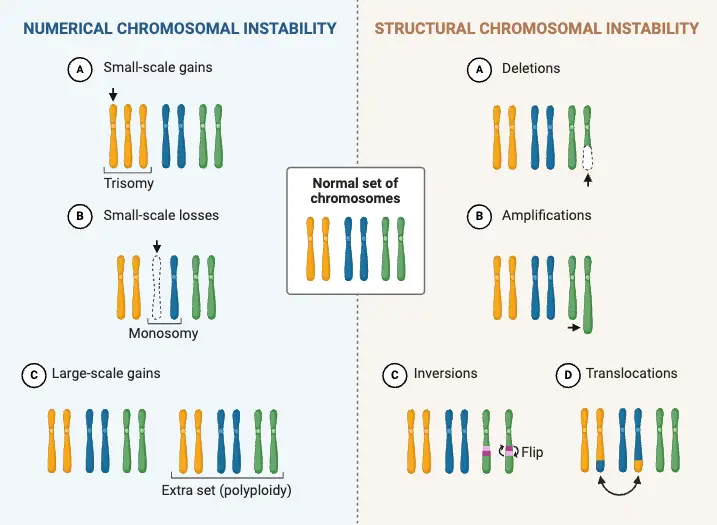
Chromosomal Mutations I: Structural Changes
- Inversion
- Definition: A chromosomal inversion occurs when a chromosome segment breaks off, rotates 180 degrees, and reattaches, reversing the order of the genes within that segment.
- Impact: This structural rearrangement can disrupt gene function and may lead to genetic disorders or affect the chromosome’s ability to pair properly during meiosis.
- Deletion
- Definition: Deletion involves the loss of a chromosome segment, resulting in the absence of certain genes.
- Impact: This can lead to a deficiency in genetic material, which may cause developmental abnormalities or genetic diseases if crucial genes are missing.
- Duplication (Amplification)
- Definition: Duplication occurs when a chromosome segment is copied and inserted into the genome, resulting in multiple copies of that segment.
- Impact: An increase in gene dosage can disrupt normal cellular function and may contribute to conditions such as cancer or other genetic disorders.
- Translocation
- Definition: Translocation involves the exchange of chromosome segments between nonhomologous chromosomes.
- Impact: This rearrangement can create novel gene combinations and may result in genetic disorders or increased susceptibility to cancer due to disrupted gene function.
Chromosomal Mutations II: Numerical Changes
- Aneuploidy
- Definition: Aneuploidy is characterized by an abnormal number of chromosomes in a cell, either through an excess or deficit of chromosomes.
- Types: Common examples include monosomy (one missing chromosome) and trisomy (one extra chromosome). Notable conditions include Down syndrome (trisomy 21) and Turner syndrome (monosomy X).
- Impact: Changes in chromosome number can lead to developmental and health issues, as seen in various genetic syndromes.
- Polyploidy
- Definition: Polyploidy refers to the presence of more than two complete sets of chromosomes in a cell.
- Types: It can be classified as autopolyploidy (additional sets of chromosomes from the same species) or allopolyploidy (additional sets from different species).
- Impact: Polyploidy is often observed in plants and can result in increased size or vigor. In animals, it can lead to reproductive difficulties or developmental anomalies.
A. Chromosomal Mutations I (Structural chromosomal changes)
Chromosomal mutations, which involve alterations in the structure of chromosomes, play a significant role in various biological processes and phenomena. These mutations are typically categorized based on the nature of the structural changes they cause. The primary types of structural chromosomal mutations include inversions, deletions, duplications/amplifications, and translocations. Each type has distinct mechanisms and implications.

- Inversion
- Definition: Inversion involves the rotation of a chromosomal segment by 180° around its own axis. This rearranges the sequence of genes without adding or losing any genetic material.
- Mechanism:
- A chromosomal segment breaks at two points.
- The segment rotates 180° and reattaches.
- Types:
- Paracentric Inversion: Does not involve the centromere. The inversion occurs within one arm of the chromosome.
- Pericentric Inversion: Involves the centromere, affecting both arms of the chromosome.
- Detection: Cytological detection is possible through inversion loops observed in meiotic nuclei.
- Genetic Impact:
- If the inversion is balanced, it typically does not lead to phenotypic changes.
- Inversion heterozygotes may experience genetic recombination issues during meiosis, leading to potential deletions or duplications.
- Example:
- In Coelopa frigida, chromosomal inversion results in phenotypic variations, such as differences in size and fitness, illustrating an evolutionary advantage.
- Deletion
- Definition: Deletion refers to the loss of a chromosomal segment due to breakage.
- Mechanism:
- Chromosomal breakage occurs.
- The missing segment results in a chromosome with a deletion.
- Types:
- Terminal Deletion: Involves the loss of a terminal segment of a chromosome due to a single break.
- Intercalary Deletion: Involves the loss of an internal segment, requiring two breaks.
- Genetic Impact:
- Deletions can be lethal in homozygous states. In heterozygous conditions, smaller deletions may still be viable.
- Example:
- Cri-du-chat Syndrome: Caused by a deletion on chromosome 5, leading to a distinct cat-like cry in affected infants, along with mental retardation and facial malformations.
- Duplication/Amplifications
- Definition: Duplication involves the presence of an extra copy of a chromosomal segment, leading to gene amplification.
- Mechanism:
- A chromosomal segment is duplicated, resulting in multiple copies of the same genes.
- Types:
- Tandem Duplication: The duplicated segment is adjacent to the original sequence.
- Reverse Tandem Duplication: The duplicated segment has a reversed gene sequence compared to the original.
- Displaced Duplication: The duplicated segment is located away from the original.
- Transposed Duplication: The duplicated segment attaches to a nonhomologous chromosome.
- Extra-chromosomal Duplication: The duplicated segment forms an independent chromosome with its own centromere.
- Genetic Impact:
- Duplications can lead to gene dosage effects, where increased gene copy numbers impact phenotype.
- Example:
- In Drosophila, duplication of the X-chromosome segment 16A results in the bar-eye phenotype, where additional copies of the segment intensify the eye’s appearance.
- Translocation
- Definition: Translocation involves the transfer of a chromosomal segment to a nonhomologous chromosome.
- Mechanism:
- A chromosomal break occurs.
- The broken segment attaches to a different chromosome.
- Types:
- Simple Translocation: A single segment is transferred to a different chromosome.
- Shift Translocation: A segment is inserted interstitially into a nonhomologous chromosome.
- Reciprocal Translocation: Two chromosomes exchange segments.
- Genetic Impact:
- Translocations do not typically result in a net gain or loss of genetic material but can create novel gene combinations and phenotypic variations.
- Example:
- Down Syndrome: Caused by a translocation of chromosome 21 onto chromosome 14.
- Leukemias: Certain translocations, such as between chromosomes 15 and 17, are associated with specific types of leukemia.
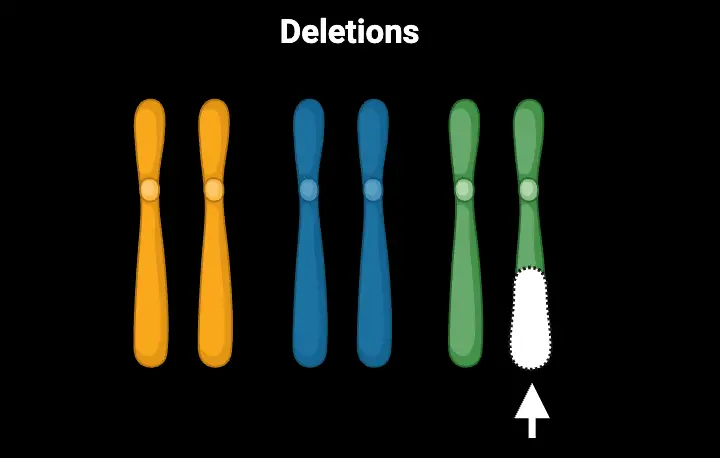
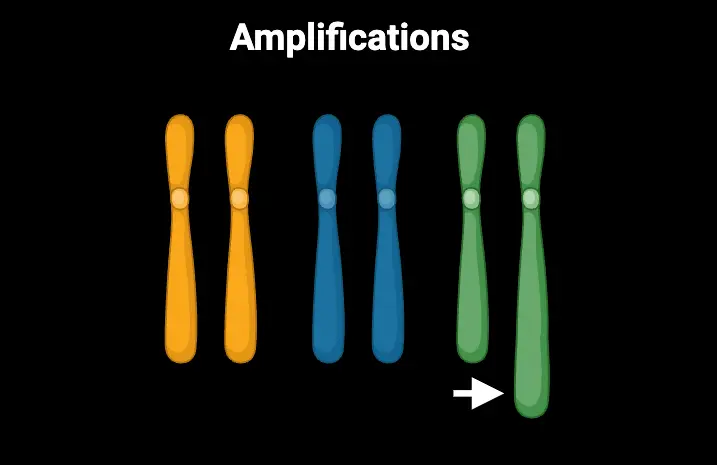
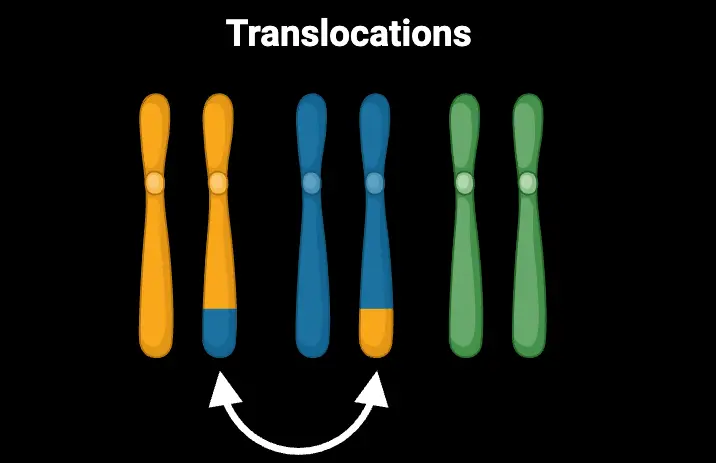
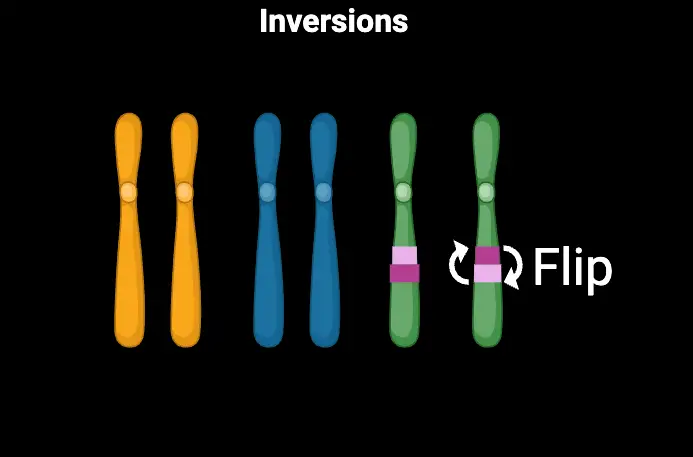
B. Chromosomal Mutations II (Numerical chromosomal changes)
Chromosomal mutations that involve alterations in the number of chromosomes are categorized under heteroploidy. This type of mutation leads to significant phenotypic changes, modifications in phenotypic ratios, and alterations in linkage groups. Heteroploidy can be further subdivided into two primary categories: aneuploidy and polyploidy. Each category has distinct mechanisms and impacts on organisms.
- Aneuploidy
- Definition: Aneuploidy refers to mutations involving the gain or loss of individual chromosomes, resulting in an abnormal number of chromosomes within a set.
- Types:
- Hypoploidy: Involves the loss of chromosomes.
- Monosomy: Loss of a single chromosome.
- Nullisomy: Loss of a pair of chromosomes.
- Hyperploidy: Involves the addition of chromosomes.
- Trisomy: Addition of a single chromosome.
- Tetrasomy: Addition of a pair of chromosomes.
- Hypoploidy: Involves the loss of chromosomes.
- Mechanism:
- Aneuploidy commonly arises due to nondisjunction during mitosis or meiosis, where chromosomes fail to separate properly.
- Impact:
- In plants, aneuploidy typically results in non-viable gametes.
- In animals, it may lead to genetic imbalances, reduced fertility, or increased mortality.
- Examples:
- Down Syndrome: Caused by trisomy of chromosome 21. This condition is characterized by a range of physical and developmental features, including mental retardation and distinctive facial features. The primary cause is the nondisjunction of chromosome 21 during gamete formation, either in oogenesis or spermatogenesis.
- Polyploidy
- Definition: Polyploidy involves the presence of more than two complete sets of chromosomes in an organism, thus exceeding the normal diploid number.
- Types:
- Autopolyploids: These organisms have multiple sets of chromosomes derived from a single species.
- Allopolyploids: These result from the hybridization between two different species, followed by chromosome doubling.
- Autoallopolyploids: These combine features of both autopolyploidy and allopolyploidy.
- Common Forms:
- Triploid: Three sets of chromosomes.
- Tetraploid: Four sets of chromosomes.
- Pentaploid, Hexaploid, Octoploid: Five, six, and eight sets of chromosomes, respectively.
- Impact:
- Polyploidy often results in gigantism, with larger cells and tissues, particularly in plants. It can also lead to reduced fertility due to difficulties in chromosome pairing during meiosis.
- Examples:
- Cynodon dactylon (Doob Grass): A triploid grass commonly cultivated in South Asia. It exhibits characteristics such as large plant size, reduced osmotic pressure, and lower growth rates due to decreased auxin content. Despite being sterile, it can be propagated vegetatively.
Advantages of Chromosomal Mutations
These benefits highlight the complex role of chromosomal mutations in evolutionary and adaptive processes.
- Survival Advantages
- Enhanced Tolerance and Immunity:
- Lactose Tolerance: A notable example of a beneficial chromosomal mutation is lactose tolerance, which allows individuals to digest lactose in dairy products. This trait became advantageous in populations that domesticated cows and goats, providing a reliable source of nutrition.
- Disease Resistance: Certain chromosomal mutations have conferred resistance to diseases. For instance, the mutation associated with sickle cell disease provides a protective effect against malaria. This mutation alters hemoglobin in red blood cells, making the cells less hospitable to the malaria parasite.
- Immunity to HIV: In some populations, chromosomal mutations have resulted in natural immunity to HIV. Specific genetic variations can prevent the virus from entering or replicating within cells, offering a significant survival advantage.
- Physical Advantages:
- Height Variations: In an Ecuadorian tribe, chromosomal mutations have led to variations in height that offer certain physical advantages, such as improved ability to navigate specific environmental conditions.
- Enhanced Tolerance and Immunity:
- Diversity
- Genetic Variation:
- Physical Traits: Chromosomal mutations contribute to the diversity of physical traits among humans. Variations in hair color, eye color, and skin pigmentation are often the result of these genetic changes. For example, the presence of blue eyes and blonde hair in some populations can be traced to specific chromosomal mutations.
- Unique Features: Features such as freckles and beauty spots, as well as variations in body shape and size, are influenced by chromosomal mutations. These traits enhance the overall genetic diversity within human populations.
- Adaptive Potential:
- Evolutionary Adaptation: The diversity introduced by chromosomal mutations can enhance the adaptive potential of populations. Diverse traits allow organisms to better cope with varying environmental pressures and challenges, increasing their chances of survival and reproduction.
- Genetic Variation:
Disadvantages of Chromosomal Mutations
The following points elucidate the primary disadvantages associated with chromosomal mutations.
- Genetic Disorders
- Chromosomal Abnormalities:
- Trisomy 21 (Down Syndrome): This condition arises from an extra copy of chromosome 21, leading to developmental delays, intellectual disabilities, and physical abnormalities such as characteristic facial features and heart defects.
- Trisomy 18 (Edwards Syndrome): Caused by an extra chromosome 18, this syndrome is associated with severe developmental and physical abnormalities, including congenital heart defects and severe intellectual disabilities. It often results in a high mortality rate within the first year of life.
- Trisomy 13 (Patau Syndrome): An extra chromosome 13 results in severe intellectual disability, physical abnormalities, and a significantly reduced life expectancy.
- Klinefelter Syndrome: This condition is characterized by the presence of an extra X chromosome in males (XXY), leading to symptoms such as reduced fertility, enlarged breasts, and taller stature.
- XYY Syndrome: Males with this condition have an extra Y chromosome, which may lead to increased height and, in some cases, behavioral issues, though many individuals remain asymptomatic.
- Turner Syndrome: Females with Turner syndrome have only one X chromosome (XO), leading to short stature, infertility, and various medical complications such as heart defects.
- Triple X Syndrome: Females with an additional X chromosome (XXX) may experience taller stature and potential learning difficulties, although many have normal development.
- Impact on Health and Function:
- These disorders often result in significant health issues, including developmental delays, physical deformities, and reduced quality of life. The severity can range from mild symptoms to life-threatening conditions.
- Chromosomal Abnormalities:
- Other Diseases
- Cancer:
- Genetic Mutations: Certain chromosomal mutations can increase the susceptibility to cancer. For instance, mutations that affect chromosome structure can lead to cancerous growths by disrupting normal cellular processes and promoting uncontrolled cell division.
- Diabetes and Asthma:
- Chromosomal Contributions: While diabetes and asthma are complex diseases with multifactorial causes, chromosomal mutations can contribute to their development. For example, mutations that influence metabolic pathways or immune responses may increase the risk of these conditions.
- Sickle Cell Anemia:
- Hemoglobin Mutation: This genetic disorder is prevalent among individuals of African descent. The mutation affects hemoglobin, leading to abnormally shaped red blood cells that can cause pain, anemia, and organ damage.
- Cancer:
Applications of Chromosomal Mutations
The following outlines the primary applications of chromosomal mutations:
- Molecular Therapy
- Genetic and Hereditary Disease Treatment:
- Chromosomal mutations are utilized in molecular therapy to address genetic disorders. By introducing specific mutations or correcting existing ones, researchers aim to rectify faulty gene functions. This approach can potentially cure or mitigate the effects of various hereditary diseases, such as cystic fibrosis and muscular dystrophy.
- Genetic and Hereditary Disease Treatment:
- Agricultural Improvement
- Plant Breeding:
- Polyploidy in Crops: Induced polyploidy, which involves increasing the number of chromosome sets, is employed to produce new plant varieties with desirable traits. For instance, polyploidy has led to the development of seedless fruits and vegetables, such as certain types of grapes and watermelons. These seedless varieties are often preferred for their convenience and market value.
- Genetic Diversity and Yield: Chromosomal mutations can also enhance plant resilience and yield. By inducing specific mutations, breeders can create crops with improved resistance to diseases, pests, and environmental stressors.
- Animal Breeding:
- Selective Breeding: Chromosomal mutations are used in animal breeding to enhance desirable traits, such as growth rate, disease resistance, and reproductive efficiency. This application involves the controlled introduction of mutations to achieve specific genetic outcomes.
- Plant Breeding:
- Evolutionary Studies
- Genomic Evolution:
- Shaping Genomes: Chromosomal mutations play a crucial role in evolutionary biology by contributing to genomic diversity. These mutations can drive the adaptation and speciation of organisms. By studying chromosomal changes, scientists gain insights into how genomes evolve and adapt to environmental pressures.
- Chromosomal Rearrangements: Rearrangements, such as inversions and translocations, provide valuable information about evolutionary processes and the mechanisms underlying genetic variation.
- Genomic Evolution:
- Biological Research
- Experimental Models:
- Monoploidy: The use of monoploid organisms, which have a single set of chromosomes, facilitates genetic experiments by ensuring that all genes are expressed. This model is valuable for studying gene function and interaction in a simplified genetic context.
- Chromosomal Mutation Design:
- Customized Genetic Solutions: Researchers can design specific chromosomal mutations to address particular biological problems. By creating mutations in targeted genes, scientists can investigate gene function and develop solutions to genetic issues.
- Experimental Models:
- Pharmaceutical Development
- Drug Discovery:
- Chromosomal mutations are employed in drug discovery to identify potential targets for therapeutic intervention. Mutant cell lines can be used to screen for drugs that specifically affect the mutated pathways or genes, leading to the development of targeted treatments.
- Drug Discovery:
Facts
- Did you know that chromosomal mutations can lead to dramatic changes in an organism’s traits, such as the development of seedless fruits or flowers with unique colors?
- Have you heard that some chromosomal mutations, like those causing polyploidy, are deliberately induced in agriculture to produce larger, more robust plants?
- Can you believe that certain chromosomal mutations can result in significant evolutionary advantages, such as enhanced disease resistance or adaptability to extreme environments?
- Did you know that aneuploidy, a type of chromosomal mutation, is responsible for several genetic disorders in humans, including Down syndrome, which is caused by an extra copy of chromosome 21?
- Have you heard that some species naturally exhibit chromosomal mutations that make them highly resilient to environmental changes, such as the ability of certain plants to thrive in polluted soils?
- Did you know that chromosomal mutations can create new genetic variations that contribute to biodiversity within a species, enhancing their ability to adapt and survive?
- Can you believe that in some cases, chromosomal mutations have been harnessed in medical research to study gene function and develop new treatments for genetic disorders?
- Did you know that polyploidy, an increase in the number of chromosome sets, is common in agricultural crops and has been used to create varieties with desirable traits like seedless fruits?
- Have you heard that chromosomal mutations can sometimes lead to unique physical traits, such as different eye colors or hair types, contributing to human diversity?
- Can you believe that the study of chromosomal mutations in different organisms can provide valuable insights into the mechanisms of evolution and the impact of genetic changes on survival and adaptation?
- Cell Biology, Genetics, Molecular Biology, Evolution and Ecology CELL BIOLOGY, GENETICS, MOLECULAR BIOLOGY, EVOLUTION AND ECOLOGY – P.S. VERMA
- https://edisciplinas.usp.br/pluginfile.php/4492534/mod_resource/content/1/Griffiths%20-%20Introduction%20to%20Genetic%20Analysis%209th%20Edition.pdf
- http://lgb.rc.unesp.br/biomol/literatura/Griffiths_8th.pdf
- https://www.biologyonline.com/dictionary/chromosomal-mutation
- Text Highlighting: Select any text in the post content to highlight it
- Text Annotation: Select text and add comments with annotations
- Comment Management: Edit or delete your own comments
- Highlight Management: Remove your own highlights
How to use: Simply select any text in the post content above, and you'll see annotation options. Login here or create an account to get started.